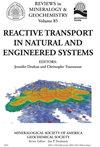跨流体-矿物边界的同位素梯度
1区 地球科学
Q1 Earth and Planetary Sciences
引用次数: 24
摘要
相内和相间稳定同位素和放射性同位素的分布提供了一种量化陆地储层中物质的来源、停留和循环的关键手段(Wahl和Urey 1935;爱泼斯坦和梅耶达1953;Johnson et al. 2004;艾勒2007;Porcelli and Baskaran 2011;2015年互联网)。虽然同位素变异性可以在全球范围内观察到,但控制其范围和分布的机制主要发生在原子尺度(如放射性衰变)、分子尺度(如质量对原子键自由能的影响)和孔尺度(如向反应表面扩散输运)。相比之下,绝大多数同位素比值测量都是基于汇总了多种途径、物种和成分的样本量。因此,从这种宏观尺度的观察推断过程需要揭示各种潜在机制的相对贡献。实际上,使用同位素作为代用物来推断特定参数,如温度(Urey 1947)或停留时间(Kaufman and Libby 1954),隐含地要求有一种机制是复合样品测量的同位素组成的主要影响因素。在本章中,我们考虑了同位素在流固相边界上分配的各种宏观尺度观测。为此,我们将连续尺度定义为界面在基本体积上平均的表示,而不是这些界面被明确分解的孔隙尺度。在这篇综述中,我们将证明,观察流固边界上的同位素分配需要一些固体表面和周围流体的同位素组成的表示,而不是“大块”或“混合良好”的储层。例如,为了(1)量化放射性和放射性成因物种的分配,(2)描述可能影响同位素比率宏观分配的输运限制,(3)解释……本文章由计算机程序翻译,如有差异,请以英文原文为准。
Isotopic Gradients Across Fluid–Mineral Boundaries
The distribution of stable and radiogenic isotopes within and among phases provides a critical means of quantifying the origin, residence and cycling of materials through terrestrial reservoirs (Wahl and Urey 1935; Epstein and Mayeda 1953; Johnson et al. 2004; Eiler 2007; Porcelli and Baskaran 2011; Wiederhold 2015). While isotopic variability is globally observable, the mechanisms that govern both their range and distribution occur largely at atomic (e.g., radioactive decay), molecular (e.g., the influence of mass on the free energy of atomic bonds) and pore (e.g., diffusive transport to reactive surface) scales. In contrast, the vast majority of isotope ratio measurements are based on sample sizes that aggregate multiple pathways, species and compositions. Inferring process from such macro-scale observations therefore requires unraveling the relative contribution of a variety of potential mechanisms. In effect, the use of isotopes as proxies to infer a specific parameter, such as temperature (Urey 1947) or residence time (Kaufman and Libby 1954), carries the implicit requirement that one mechanism is the primary influence on the measured isotopic composition of the composite sample. In the present chapter, we consider a wide variety of macro-scale observations of isotope partitioning across fluid–solid phase boundaries. For this purpose we define the continuum scale as a representation in which interfaces are averaged over elementary volumes, as opposed to the pore scale in which these interfaces are explicitly resolved. Throughout this review it will be demonstrated that observations of isotope partitioning across fluid–solid boundaries require some representation of the isotopic composition of the solid surface and surrounding fluid distinct from ‘bulk’ or ‘well mixed’ reservoirs. For example, this distinction is necessary in order to (1) quantify the partitioning of radioactive and radiogenic species, (2) describe transport limitations that may impact the macroscopic partitioning of isotope ratios, (3) explain …
求助全文
通过发布文献求助,成功后即可免费获取论文全文。
去求助
来源期刊

Reviews in Mineralogy & Geochemistry
地学-地球化学与地球物理
CiteScore
8.30
自引率
0.00%
发文量
39
期刊介绍:
RiMG is a series of multi-authored, soft-bound volumes containing concise reviews of the literature and advances in theoretical and/or applied mineralogy, crystallography, petrology, and geochemistry. The content of each volume consists of fully developed text which can be used for self-study, research, or as a text-book for graduate-level courses. RiMG volumes are typically produced in conjunction with a short course but can also be published without a short course. The series is jointly published by the Mineralogical Society of America (MSA) and the Geochemical Society.
 求助内容:
求助内容: 应助结果提醒方式:
应助结果提醒方式:


